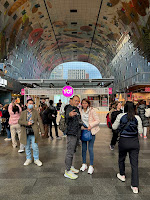From the Hague I took a train, which delivered me to Rotterdam, to the quite city centre, only in 20 minutes.
Rotterdam, with a population of over 650000, is the second-largest city in the Netherlands, after Amsterdam. It was first mentioned in the 13th century and grew as a fishing village along the Rotte River (still there are three other main rivers flowing through the city). It became a major port and trade center during the Dutch Golden Age, but it was heavily bombed in World War II, leading to a complete rebuild with modern architecture.
It feels more vibe here on the streets rather than in the Hague. But the architecture also looks a bit simpler.
My hotel is located on Witte de Withstraat, one of the city's trendiest and most vibrant streets, known for its artistic vibe, filled with bars, galleries, boutiques and cool restaurants. There is a self check-in, so I needed to wait until 3pm to get the code to the entrance.
The room is small, but it has a distinctive feature, which I paid for. It is the view to the street and to the other beautiful houses.
Rotterdam is a home to Europe’s largest port, known as the “Gateway to the World”. The port stretches over 40 kilometers and handles millions of containers, goods, and raw materials every year.
In general, Rotterdam has a vast network of harbors, with more than 40 harbors spread across the city. One of the most interesting for tourists are Wijnhaven, Kop van Zuid and Leuvehaven. Wijnhaven is a historic harbor area, now a vibrant district with modern apartments and dining options; Kop van Zuid is a large waterfront area featuring several harbors for recreational boats and modern buildings; Leuvehaven is known for its maritime museum and historic vessels.
There were several unexpected discoveries in the city, while I was randomly strolling around.
The first is the Markthal, a giant indoor food market with an arched ceiling covered in colorful artwork. The building features a unique horseshoe-shaped arch with a glass facade, making it the largest glass-window cable structure in Europe. Above the market hall, there are 228 apartments, and below, a four-story underground parking garage with over 1200 spaces.
The second is the mirrored facade of Depot Boijmans Van Beuningen. The building features a unique cylindrical shape covered in 1664 reflective glass panels, which mirror the Rotterdam skyline, creating a truly magical impression. The reflective surface also captures the trees, water and buildings around the museum, giving the structure a dynamic and ever-changing appearance.
Quite intensive day, but only 23000 steps were made. Still, for the dessert today I have deserved a wonderful brownie from the local coffeeshop.
Going to sleep with one thing on my mind, that tomorrow I finally will visit the famous Van Gogh museum!




















No comments:
Post a Comment